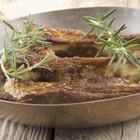bhofack2/iStock/GettyImages
Cooking a prime rib roast in your oven is a relatively straightforward process, with the variables limited to how you season the meat and whether you favor high- or low-temperature cooking. Using a rotisserie takes the beef to a different level, cooking the meat evenly from all sides. This gives a more consistent roast, with less variation between more-cooked and less-cooked areas. Some rotisseries are complete, self-contained cookers, while other electric spits are designed to work with an external fire. All of them can produce a superior roast.
A Few Fundamentals
A prime rib or standing rib roast is one of the costliest and showiest beef roasts. The full prime rib includes the first seven of the steer's rib bones, and the tender and superbly marbled muscles attached to them. These consist of the large central rib-eye, and the equally tender "cap" muscle wrapped around most of its diameter. Fireplace spits and the rotisseries of some grills can accommodate a full prime rib, but smaller portions of two to four ribs are a more common choice. The smallest countertop rotisseries might not have room for the ribs to rotate freely, so you might have to trim them away and convert your rib roast to a rib-eye.
Countertop Electric Rotisseries
Self-contained rotisserie ovens vary widely in quality, from cheaply made units sold on late-night infomercials to rugged versions from leading kitchenware manufacturers. Season the roast liberally with salt and pepper or other flavorings as desired, then turn it in your hands a few times to find its center of gravity. Insert the main spit and smaller spit rods, and check the balance. Remove and replace the spit to correct any imbalance if necessary, then lock the spit into place and set the oven for your preferred cooking temperature. Cook until the beef reaches an internal temperature of 130 to 135 degrees Fahrenheit for medium-rare.
Grill-Based Electric Rotisserie
Most major manufacturers offer electrically powered rotisseries for their grills, and a brisk demand also exists for aftermarket rotisseries from third-party manufacturers. Balancing your roast on the spit is crucial to avoid unnecessary stress on the motor, so take your time getting it right. Set up your grill so the heat comes from the sides, rather than under the rotisserie. On a gas grill you'd light the side burners but not the middle, and on a charcoal grill you'd rake your coals to a side parallel to the spit. Place a drip tray under the roast to prevent flare-ups, and cook it at moderate heat with the lid down until it reaches your desired degree of doneness.
Open-Hearth Electric Spit
The showiest and most traditional way to spit-roast your prime rib is in front of an open fire, either on the hearth of your fireplace or at an outdoor pit. Build a fire of hardwoods or of charcoal if you're cooking outdoors. Season and spit the roast, taking care that it's well balanced, and lock the spit into the rotisserie. Place a pan underneath the roast to catch the drippings, and use them to baste it periodically. When the roast is cooked to your preferred degree of doneness -- usually medium-rare, for prime rib -- remove it from the spit and let it rest for 15 to 20 minutes before carving. Skim the fat from the drippings and use them to make gravy, if you wish.
Related Articles

How to Cook Prime Rib Using an Oven ...

How to Rotisserie Cook Without a ...
How do I Cook a Prime Rib on an Open ...

How to Cook a Goose on the Grill
How to Cook With a Reverse Flow Smoker
How to Cook a Standing Rib Roast on a ...

How to Cook a Beef Roast Over an Open ...

How to Cook a Standing Rib With the ...

How to Cook Spare Ribs in a Rotisserie

How Long Can You Cook Beef Ribs at 300 ...

How to Grill a Ribeye on a Weber Q
How to Cook on an Electric Rotisserie

Does a Roaster Oven Cook Faster Than ...

What Is the Best Cookware for Electric ...
How to Cook a Spencer Roast

How to Smoke a Sirloin Tip Roast

How to Sear Ribs

How to Cook a Restaurant-Quality Prime ...

How to Cook Deer Sirloin

How to Barbeque Boneless Prime Rib on a ...
References
Writer Bio
Fred Decker is a trained chef and prolific freelance writer. In previous careers, he sold insurance and mutual funds, and was a longtime retailer. He was educated at Memorial University of Newfoundland and the Northern Alberta Institute of Technology. His articles have appeared on numerous home and garden sites including GoneOutdoors, TheNest and eHow.